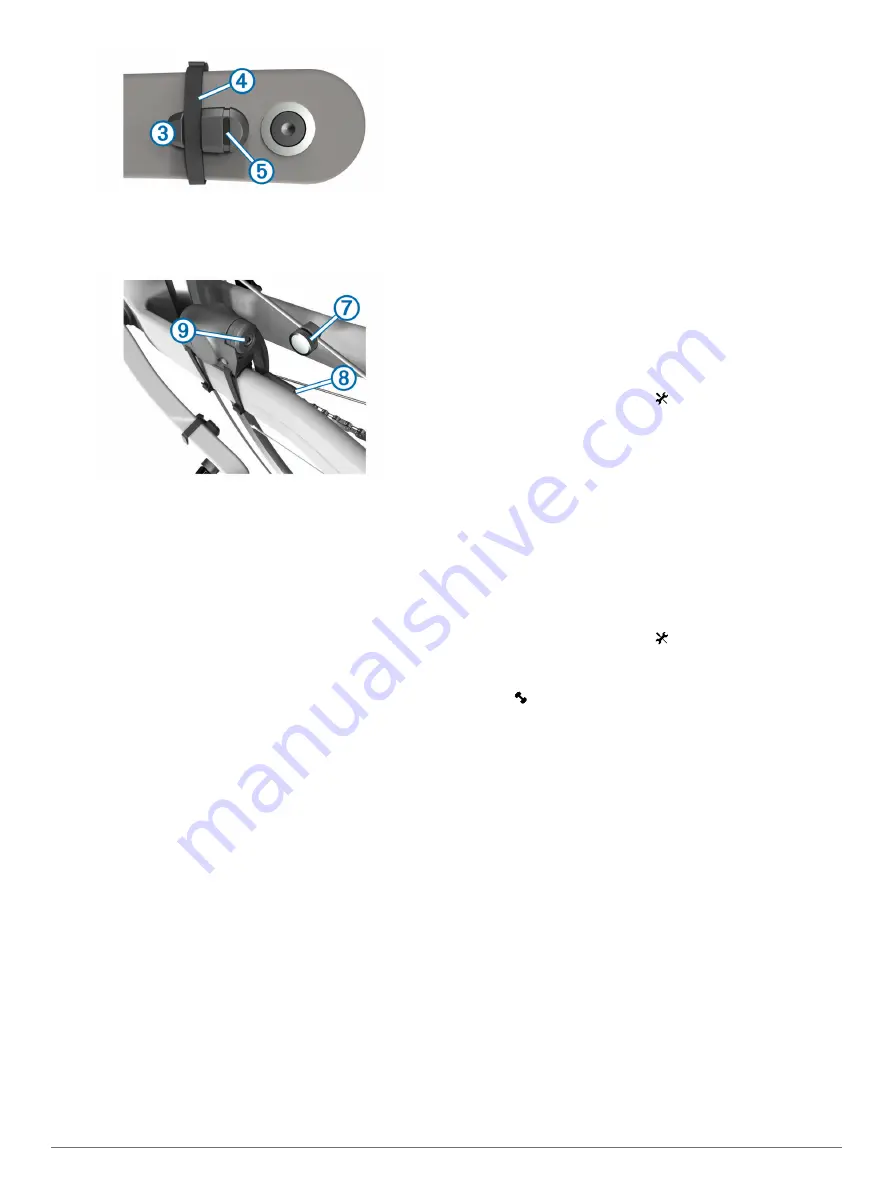
The pedal magnet must be within 5 mm of the GSC 10. The
indication line
Ä
on the pedal magnet must line up with the
indication line
Å
on the GSC 10.
5
Unscrew the spoke magnet
Æ
from the plastic piece.
6
Place the spoke in the groove of the plastic piece, and tighten
it slightly.
The spoke magnet can face away from the GSC 10 if there is
not enough room between the sensor arm and the spoke.
The spoke magnet must line up with the indication line
Ç
on
the sensor arm.
7
Loosen the screw
È
on the sensor arm.
8
Move the sensor arm to within 5 mm of the spoke magnet.
You can also tilt the GSC 10 closer to either magnet to
improve alignment.
9
Select
Reset
É
on the GSC 10.
The LED turns red, then green.
10
Pedal to test the sensor alignment.
The red LED blinks each time the pedal magnet passes the
sensor. The green LED blinks each time the spoke magnet
passes the sensor arm.
NOTE:
The LED blinks for the first 60 passes after a reset.
Select Reset again if you require additional passes.
11
When everything is aligned and working correctly, tighten the
cable ties, the sensor arm, and the spoke magnet.
Garmin recommends that the torque is 1.9 to 2.4 lbf-in. (0.21
to 0.27 N-m) to ensure a water tight seal on the GSC 10
sensor arm.
About the GSC 10
Cadence data from the GSC 10 is always recorded. If there is
no GSC 10 paired, GPS data is used to calculate the speed and
distance.
Cadence is your rate of pedaling or “spinning” measured by the
number of revolutions of the crank arm per minute (rpm). There
are two sensors on the GSC 10: one for cadence and one for
speed.
Data Averaging for Cadence or Power
The non-zero data-averaging setting is available if you are
training with an optional cadence sensor or power meter. The
default setting excludes zero values that occur when you are not
pedaling.
You can change the value of this setting (
Training with Power Meters
• Go to
for a list of ANT+ sensors
that are compatible with your device (such as Vector
™
).
• For more information, see the owner's manual for your power
meter.
• Adjust your power zones to match your goals and abilities
(
).
• Use range alerts to be notified when you reach a specified
power zone (
).
• Customize the power data fields (
).
Setting Your Power Zones
The values for the zones are default values and may not match
your personal abilities. You can manually adjust your zones on
the device or using Garmin Connect. If you know your functional
threshold power (FTP) value, you can enter it and allow the
software to calculate your power zones automatically.
1
From the home screen, select >
Training Zones
>
Power
.
2
Enter your FTP value.
3
Select
Based On:
.
4
Select an option:
• Select
Watts
to view and edit the zones in watts.
• Select
% FTP
to view and edit the zones as a percentage
of your functional threshold power.
Calibrating Your Power Meter
Before you can calibrate your power meter, it must be properly
installed, paired with your GPS device, and actively recording
data.
For calibration instructions specific to your power meter, refer to
the manufacturer's instructions.
1
From the home screen, select .
2
Select
Bike Profiles
.
3
Select a profile.
4
Select >
Calibrate
.
5
Keep your power meter active by pedaling until the message
appears.
6
Follow the on-screen instructions.
Pedal-Based Power
Vector measures pedal-based power.
Vector measures the force you apply a few hundred times every
second. Vector also measures your cadence or rotational
pedaling speed. By measuring the force, the direction of force,
the rotation of the crank arm, and time, Vector can determine
power (watts). Because Vector independently measures left and
right leg power, it reports your left-right power balance.
NOTE:
The Vector S system does not provide left-right power
balance.
Using Shimano
®
Di2
™
Shifters
Before you can use Di2 electronic shifters, you must pair them
with your device (
). You
can customize the optional Di2 data fields (
). The Edge 810 device displays current
adjustment values when the sensor is in adjustment mode.
Situational Awareness
Your Edge device can be used with Varia
™
smart bike lights and
rearview radar to improve situational awareness. See the
owner's manual for your Varia device for more information.
8
ANT+ Sensors


























